July 2009
Welcome to this issue of the Hardwood Tree Improvement and Regeneration Center E-newsletter. The HTIRC is committed to enhancing the productivity and quality of Central Hardwood Region trees and forests for the economic and environmental benefits they provide. Scientists at the HTIRC are using conventional tree improvement breeding as well as molecular and genetic technologies to improve the wood quality, growth characteristics, and insect and disease resistance of trees like black walnut, black cherry, red and white oaks, butternut and American chestnut.
Research in tissue culture, tree nursery practices, tree plantation establishment and management, and Central Hardwoods silvicultural systems is aimed at increasing the regeneration
success rate for high quality hardwood trees and forests. Some interesting and unusual research areas include examining the potential for propagating trees with “figured” wood: birds-eye maple or curly walnut; and breeding trees that will be an economical source of bio-fuels.
Twice per year, we will attempt to provide interesting and useful information on Central Hardwood trees and forests, as well as sources for additional information and assistance.
Please pass this newsletter along to others who may enjoy or benefit from the information provided. If you would like a closer look at the HTIRC, please visit our web site at: http://www.htirc.org
Colorado State University Finds Thousand Cankers Disease a Newly Recognized Threat to U.S. Black Walnut Population
FORT COLLINS – Black walnut trees in the U.S. are facing a very serious new threat called thousand cankers disease according to Colorado State University researchers. This recently recognized problem has already devastated black walnut trees west of the Rocky Mountains over the past 10-15 years.
“Thousand cankers disease is caused by a newly discovered fungus that is carried to trees by a tiny bark beetle,” said Ned Tisserat, a plant pathologist at Colorado State, who first identified the fungus last summer. “The fungus then colonizes and kills a small area of the bark surrounding beetle galleries. The number of beetle galleries and associated dead bark, called cankers, in a tree is enormous. Cankers eventually fuse and girdle limbs and the trunk so that nutrients can no longer move in the tree.”
Trees typically die within a couple of years after they first show symptoms of leaf yellowing and branch dieback.
The walnut twig beetle, a native insect of the Southwest, is usually associated with the Arizona walnut tree, to which it is not harmful. It is, however, harmful to the black walnut tree which is highly valued for its wood and nuts. Although it is native to the East, black walnut has been planted extensively throughout the West.
“The walnut twig beetle has shown a fantastic spread through the western United States within the past 25 years,” says Whitney Cranshaw, an entomologist at Colorado State, who is working with Tisserat. “In recent years we have seen new records for this insect in Colorado, northern New Mexico, Utah, Idaho, Oregon and Washington. And everywhere we are finding the beetle, all the black walnuts are dying.”
The bigger concern is thousand cankers disease moving east where black walnut is a common forest species.
“I think thousand cankers disease has the potential to devastate black walnut just as Dutch elm disease nearly wiped out American elm and chestnut blight eliminated American chestnut,” said Cranshaw. “Right now it is contained in the West but all it would take is one careless individual moving a walnut log with the beetles and we could have an outbreak that could quickly spiral out of control.”
Tisserat and Cranshaw emphasize the importance of foresters, arborists, woodworkers and lumber mills to recognize this new threat. They say no walnut logs with bark intact should be allowed to move further east than where the disease is currently known. Walnut wood and well-dried logs without bark likely pose little threat of carrying the fungus-carrying beetles.
Manfred Mielke, a U.S. Forest Service Plant Pathologist, has pointed out that the natural range of black walnut (Juglans nigra) overlaps the range of little walnut (Juglans microcarpa) in parts of Texas and Oklahoma, providing a possible bridge for thousand cankers disease to move eastward. In addition, settlers crossing the Great Plains on the Sante Fe, Oregon, and other wagon trails planted black walnut trees in towns and farms along the route, providing another possible bridge for the western infestations to spread eastward. There are many questions to be answered about the biology and potential for spread of thousand cankers disease, but its impact on black walnut in western states suggests it is a threat to be taken seriously.
For more information, contact Ned Tisserat at (970) 491-6527 or Ned.Tisserat@colostate.edu or visit http://www.ext.colostate.edu/pubs/insect/0812_alert.pdf
Dr. Keith Woeste, Research Molecular Geneticist with the HTIRC, is currently working with Dr. Tisserat and several other investigators to provide seedling selections for screening of native and exotic walnut species for susceptibility to infection from the thousand cankers disease fungus. This work will take place at Colorado State University. Examination of genetically distinct selections from several species of walnut, as well as pecan and hickory species, may identify variations in susceptibility to the fungus and help with identification of management practices or sanitation and quarantine procedures that may be needed to prevent spread of the disease, and significant damage to populations of black walnut and other members of the walnut family.
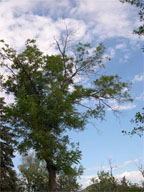
Crown thinning and leaf yellowing of black walnut
associated with Thousand Cankers Disease. As the disease progresses
the foliage will wilt and tree death follows shortly thereafter.
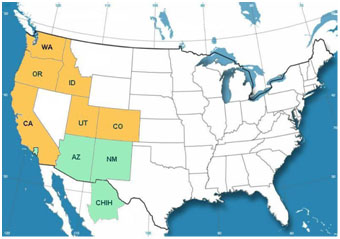
Distribution of the walnut twig beetle. In green are states and the
California county of Los Angeles with records of the species prior
to 1992. States in gold have reported the insect since 1998.
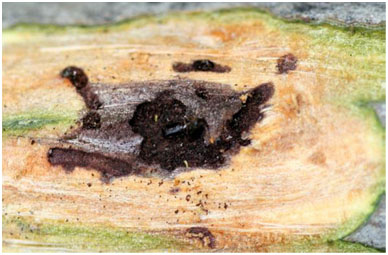
Walnut twig beetle in the photo center, and associated staining around tunnel.
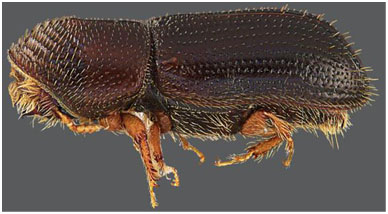
Walnut twig beetle, side view. The actual size of the beetle is 1.5 to 1.9 millimeters.
Photograph by Jim LaBonte, Oregon Department of Agriculture.
Reviving American Chestnuts May Mitigate Climate Change
A Purdue University study shows that introducing a new hybrid of the American chestnut tree would not only bring back the all-but-extinct species, but also put a dent in the amount of carbon in the Earth’s atmosphere.
Douglass Jacobs, an associate professor of forestry and natural resources, found that American chestnuts grow much faster and larger than other hardwood species, allowing them to sequester more carbon than other trees over the same period. And since American chestnut trees are more often used for high-quality hardwood products such as furniture, they hold the carbon longer than wood used for paper or other low-grade materials.
“Maintaining or increasing forest cover has been identified as an important way to slow climate change,” said Jacobs, whose paper was published in the June issue of the journal Forest Ecology and Management. “The American chestnut is an incredibly fast-growing tree. Generally the faster a tree grows, the more carbon it is able to sequester. And when these trees are harvested and processed, the carbon can be stored in the hardwood products for decades, maybe longer.”
At the beginning of the last century, the chestnut blight, caused by an introduced fungus, rapidly spread throughout the American chestnut’s natural range, which extended from southern New England and New York southwest to Alabama. About 50 years ago, the species was nearly gone.
New efforts to hybridize remaining American chestnuts with blight-resistant Chinese chestnuts have resulted in a species that is about 94 percent American chestnut with the protection found in the Chinese species. Jacobs said those new trees could be ready to plant in the next decade, either in existing forests or former agricultural fields that are being returned to forested land.
“We’re really quite close to having a blight-resistant hybrid that can be reintroduced into eastern forests,” Jacobs said. “But because American chestnut has been absent from our forests for so long now, we really don’t know much about the species at all.”
Jacobs studied four sites in southwestern Wisconsin that were unaffected by the blight because they are so far from the tree’s natural range. He compared the American chestnut directly against black walnut and northern red oak at several different ages, and also cross-referenced his results to other studies using quaking aspen, red pine and white pine in the same region.
In each case the American chestnut grew faster, having as much as three times more aboveground biomass than other species at the same point of development. American chestnut also sequestered more carbon than all the others. The only exception was black walnut on one site, but the American chestnut absorbed more carbon on the other study sites.
“Each tree has about the same percentage of its biomass made up of carbon, but the fact that the American chestnut grows faster and larger means it stores more carbon in a shorter amount of time,” Jacobs said.
Jacobs said trees absorb about one-sixth of the carbon emitted globally each year. Increasing the amount that can be absorbed annually could make a considerable difference in slowing climate change, he said.
“This is not the only answer,” Jacobs said. “We need to rely less on fossil fuels and develop alternate forms of energy, but increasing the number of American chestnuts, which store more carbon, can help slow the release of carbon into the atmosphere.”
Carbon dioxide is considered a major greenhouse gas, responsible for rising global temperatures.
Jacobs said that since this study looked at aboveground carbon sequestration, future studies would seek to understand more about how forests that contain American chestnuts store carbon below the ground. The Stry Foundation, Electric Power Research Institute, and Hardwood Tree Improvement and Regeneration Center funded the research.
Writer: Brian Wallheimer, 765-496-2050, bwallhei@purdue.edu
Source: Douglass Jacobs, 765-494-3608, djacobs@purdue.edu
Additional information about the efforts to restore American chestnut is available from the American Chestnut Foundation, an HTIRC partner organization.
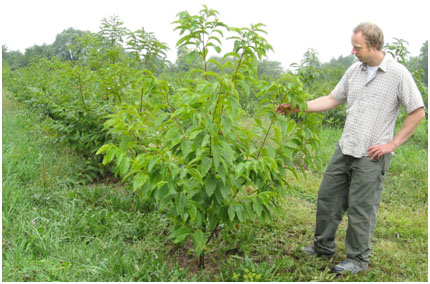
Douglass Jacobs examines a young hybrid of the American chestnut.
He expects the trees could be reintroduced in the next decade.
(Purdue University file photo/Nicole Jacobs)
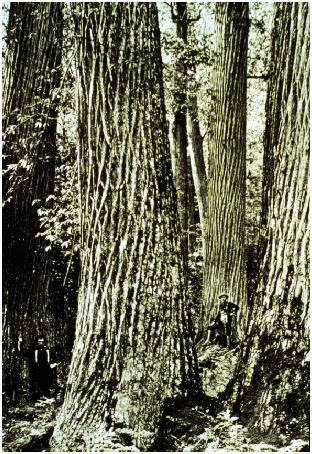
Old-growth American chestnut trees. American chestnut
was one of the largest trees in eastern North America, sometimes
referred to as “the redwood of the east”.
Photo by S.V. Streeter, January 15, 1910
Protecting Ash Trees from Emerald Ash Borer
The exotic beetle Emerald Ash Borer (EAB) has already killed millions of ash trees in states like Michigan, Indiana, and Ohio. While infested areas expand in these states, several new states have been added to the list of EAB outbreak locations. EAB has the potential to kill every ash, from saplings to large, mature trees, in urban and rural areas. Quarantines on the movement of material that could be infested with EAB are in place to prevent the rapid spread of this pest, but many locations across the country already face elimination of ash trees if no action is taken. Controlling EAB in the forest environment may not be economically feasible with the tools currently available, but several options are available to conserve individual trees of high value, such as yard and street trees.
Several commercial and homeowner-approved chemical treatments may provide protection for ash trees as EAB moves into new areas. The North Central IPM Center and the Cooperative Emerald Ash Borer Program have recently released a new publication, Insecticide Options for Protecting Ash Trees from Emerald Ash Borer, which provides research-based information on several chemical treatment options available to landowners and commercial applicators. Only one chemical currently licensed for homeowner use has been tested, Bayer Advanced Tree and Shrub Insect Control with the active ingredient imidacloprid. Several options are available through professional applicators, including one product, with the active ingredient emamectin benzoate, that can provide protection for two years. Most treatments must be done annually or twice per season to provide protection from EAB.
If your ash trees are within 10 to 15 miles of a known EAB infestation, consider beginning treatment now. The homeowner-approved treatment can be effective for smaller ash trees, but if your ash have trunks larger than 15 inches in diameter at 4.5 feet above the ground, you should contact a professional applicator. The homeowner-approved treatment must be done annually to maintain protection from EAB. Always read and follow the label directions whenever applying pesticides – it’s the law!
Access to the publication and additional information about EAB and ash trees can be found at: http://www.emeraldashborer.info/
A calculator has been developed by the Purdue University Department of Entomology that allows landowners and managers to evaluate the cost through time of three management options for ash trees facing EAB attack: removal, removal and replacement, and pesticide treatment. The calculator can be accessed at http://extension.entm.purdue.edu/treecomputer/
HTIRC Research Plant Physiologist, Dr. Paula Pijut is currently working on a method to provide native ash trees with a natural chemical defense against EAB attack. This research will be highlighted in our next email newsletter.

Red dots indicate confirmed EAB finds. Visit http://www.emeraldashborer.info/ for
regular updates on EAB find locations.
The Farm Bill and Forestry – Opportunities for Landowners
This summer is a good time to start planning for tree plantings and forest management practices to be implemented next spring. The Federal Governments’ 2008 Farm Bill includes several programs designed to assist landowners who wish to install or maintain conservation practices on their properties. The 2008 Farm Bill has expanded opportunities for non-industrial private forest landowners to meet eligibility requirements and receive financial assistance with several tree planting and forest management practices. These programs are administered through the USDA Natural Resources Conservation Service (NRCS) and the Farm Services Agency (FSA), which have offices in most counties across the country.
Some of the programs and practices that may be applicable to forest landowners and landowners wishing to install conservation tree plantings are:
- The Environmental Quality Incentives Program (EQIP) has the widest variety of practices available to forest landowners, including forest stand improvement, controlling erosion on forest roads, tree and shrub planting, weed control in tree plantings, tree pruning, planting riparian buffers, windbreaks or shelterbelts, and controlling invasive species in the forest.
- The Wildlife Habitat Incentives Program (WHIP) provides a similar package of practices aimed at improving wildlife habitat on properties, including wetland restoration, invasive species control, and tree and shrub planting. EQIP and WHIP pay a set amount per unit (acres, feet, etc.) of practice successfully completed.
- The Conservation Reserve Program (CRP) is designed to retire highly erodible or environmentally sensitive land with a cropping history from production. Several tree and shrub planting options are available in this program, depending on the historic use and soil properties of the parcel. This program provides excellent incentives for tree planting through cost sharing of planting and establishment costs, plus annual payments for periods of 10 to 15 years, based on the practices installed and the soil productivity of the area. A new provision in CRP allows for cost sharing on thinning, prescribed burning, pruning, and vegetation management necessary to improve the condition of the planting, making this program even more attractive for landowners looking at fine hardwood timber management.
- Several conservation easement programs, like the Wetland Reserve Program (WRP), Healthy Forest Reserve Program (HFRP), and the Forest Legacy Program (available through the USDA Forest Service) may be available to landowners in selected watersheds or targeted conservation areas. These programs provide an opportunity for landowners to receive a payment for granting a conservation easement on the parcel, preventing future development or change of use. These programs may also provide assistance with planting and habitat restoration practices.
Eligibility criteria varies between programs and practices, but in general you must have a forest stewardship or forest management plan, which provides a map, description of, and background information on the parcel, a description of the owners management objectives, a description of the natural resources on the property including any areas or situations of concern like invasive species or sensitive areas like wetlands, and a description and map of practices planned for implementation, along with the schedule for management activity. In some cases, landowners may be eligible for financial assistance with developing a forest plan meeting the requirements for the program. Technical assistance with developing a plan can be obtained from private consulting foresters, industry foresters, and foresters working with branches of state or local government, as well as the Natural Resources Conservation Service. You can contact your local NRCS office for a listing of foresters who can assist you.
Additional information and application procedures for these programs is available from the USDA NRCS or FSA office in your area. If you are interested in any of these programs, visit your local USDA office soon, since sign-up for some of these programs concludes in September.
The HTIRC Obtains a Vast Amount of New Butternut Seed in the Fall of 2008
For years, Keith Woeste, HTIRC Research Molecular Geneticist, has been contacting state and private foresters and interested landowners across the range of butternut to locate surviving healthy butternut trees in the forests. 2008 was an excellent butternut seed crop and Keith received grants from the USDA-Forest Service State & Private Forestry and The Nature Conservancy in Indiana to collect seed. Foresters and landowners collected the seed and mailed it along with a description and location of each tree to HTIRC. For a few sources, students from Purdue University went out to collect on-site. At the present time, nearly 300 new seed accessions (seed from a single mother tree) were obtained varying from a few nuts per tree to as many as 300. In total, about 15,000 seed were received.
The seed began arriving in mid September and continued through January of 2009. Seed that had arrived by October 20th was fall sown at the IN DNR Vallonia Nursery. Seed that arrived after October 20th was cleaned and stratified in a cooler. We were fortunate to secure an additional 140 feet of nursery bed space at Vallonia and this stratified butternut seed was spring sown in early May. It turned out that we had so much seed, it would have required approximately 600 more feet of bed space and we had to seek alternatives.
To that end, we contacted Aaron Flickinger at the Iowa DNR who is interested and actively working on butternut conservation in Iowa. We kept 15 seed for each accession and all of the excess was separated and bagged for Iowa. Iowa DNR staff drove over to Purdue in early May and picked up the seed along with 140 extra butternut seedlings (14 families with 10 trees each) that were 1-0 planting stock from USDA Forest Service Research Plant Pathologist Mike Ostry’s Rosemont, MN butternut orchard – trees that the HTIRC had added to their butternut breeding orchard this spring. Once we planted the spring-sown bed at Vallonia, we still had more seed left. That seed was returned to Purdue and was planted in about 500 containers in the greenhouse for future use.
Next year, 4 to 10 seedlings from each source will be planted into a new butternut breeding and screening block for the HTIRC at Purdue. Ron Overton, HTIRC Nursery and Tree Improvement Specialist, has a new USDA-Forest Service State & Private Forestry project beginning in 2009-‘10 and HTIRC will make extra seedlings from all of this material available to other researchers. As seedlings are available, they will be sent to 3 different groups: DNA analysis will be conducted to make certain which sources are pure butternut as opposed to hybrids with Japanese walnut (University of Notre Dame, in Indiana); another group will be planted in a conservation orchard in western Iowa (Iowa DNR) for long-term conservation; and a 3rd group will be sent to Connecticut for screening with the butternut canker fungus by the USDA (Connecticut Agricultural Experiment Station)
Partnership Results in Hardwood Forestry Plantings at Steelcase Facility
By Jim McKenna, Operational Tree Breeder, USDA-Forest Service
A former Purdue student, now a Steelcase employee, read about the HTIRC in a Purdue communication, and saw an opportunity for the HTIRC and Steelcase to partner together in tree improvement research and environmental sustainability. The emphasis of the HTIRC on fine hardwood species like black walnut, black cherry, and northern red oak, with the aim of improving their timber quality, was compelling to Kevin Kuske, Steelcase Wood Division, since so much veneer is scrapped during the furniture making process. As part of Steelcase’s environmental policy, Kevin was very interested in growing trees on Steelcase land as a means of fixing carbon and thereby offsetting CO2 emissions from the manufacturing process. Rather than simply purchasing carbon credits, Kevin’s interest was to actually fix carbon locally in trees through reforesting Steelcase land. Additionally, if all goes well, these plantings could eventually provide a supply of “locally-grown” veneer for Steelcase to permanently fix carbon in new wood furniture later this century.
In the fall of 2007, we began to determine the soil types suitable for growing fine hardwood trees around the Wood Plant. There is a great deal of soil variation there – both too wet and too dry – and only soil that is fairly rich and well drained is suitable for black walnut, black cherry, and northern red oak. We found some suitable soil directly south of the plant, adjacent to a native woodlot. During the first week of May 2008, 3 colleagues and I traveled to the Wood Plant with our trees, tractors, and deer fencing supplies. Linda Thompson soon became our Steelcase-forestry project manager and within that week, we had planted 1,920 black walnut, 1,856 northern red oak, and several hundred tulip poplar and bur oak border trees on the site behind the plant for a grand total of just over 4,000 trees. Right after the trees were planted, we erected a 7.5-foot-tall plastic deer fence to keep white tailed deer from eating and damaging the trees. Kevin and Linda conducted a small test by planting about two hundred extra trees outside of the deer fence and found significant damage and mortality due to deer. Thus, we have determined deer fencing is necessary for plantings here.
This year, we had hoped to continue to plant alongside the main woodlot to continue to increase the size of the existing forested land. By late March, when we traveled to Grand Rapids to mark the actual planting area, we found much of this area flooded and determined it was not going to be possible to plant this spot this year. Instead, we chose a new area where better soils for fine hardwood trees occur on the property. Like last year, four of us traveled to Steelcase the first week of May and marked the site, planted the trees, built the deer fence, and mapped the identity of every tree – all within 4 days! Linda Thompson and numerous hard-working Steelcase employees provided invaluable help once again and made the work fun too. We were also very fortunate to have Roger Corwin, a local Grand Rapids resident and the current President of the Michigan Walnut Council, come out and help throughout the week. This year’s planting included additional black walnut and northern red oak progeny tests, each with 1,536 and 1,264 trees respectively. In addition, we planted a black cherry progeny test with 256 trees and a grafted black walnut “clone-trial” with 100 grafted black walnut and 100 comparison seedlings. We bordered one side of the planting near a road with about 150 white pine and red bud trees and a row of American chestnut. Between the walnut and red oak tests, we planted a three row border of butternut, hybrid butternut, river birch, and bur oak. This 2009 planting contains about 4,000 trees in total.
We plan to add at least two more years of plantings to the Steelcase site. Next year, we’ll have another black walnut and black cherry test. In 2011, we should have those two species and another northern red oak test. We establish all test plantings in accordance with good forestry management practices: proper site selection, weed control around the trees, and replanting if need be to keep the density of the trees high, at least 650 per acre (we start at 680 per acre). Once established, we measure the growth and timber quality of the trees in each test at 3,5,8,10,13, and 15 years. After the 3rd and 5th year measurements, we will prune each tree to a single stem. By the 10th year, we typically thin out ½ of the trees to allow room for the remaining trees to grow to maturity.
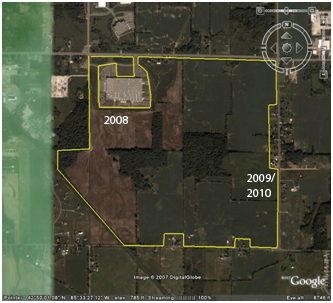
Overview of the forestry plantings on Steelcase Wood Plant land.
HTIRC Involvement in National and International Conferences
HTIRC staff is involved as organizers and presenters at several upcoming conferences.
The 100th annual meeting of the Northern Nut Growers Association (NNGA) will be held at Purdue University, West Lafayette, Indiana from July 19 thru 23, 2009. Jim McKenna, HTIRC Operational Tree Breeder, is the local arrangements chair for the meeting and several HTIRC staff and research projects will be highlighted during the meeting. Details are at: http://www.icserv.com/nnga/
The Walnut Council will have their annual international meeting in Clarksville, Indiana from August 2 thru 5, 2009. The Walnut Council primary goals are to assist in the technical transfer of forest research to field applications, help build and maintain better markets for wood products and nut crops, and to promote sustainable forest management, conservation, reforestation, and utilization of American black walnut (Juglans nigra) and other high quality fine hardwoods. The Walnut Council is a partner organization with HTIRC, working together to improve the quality and management of fine hardwood trees. Meeting details are available at: http://www.walnutcouncil.org/
The Symposium on Ash in North America will be held in West Lafayette, IN, March 9-11, 2010. Ash trees in urban and rural forest environments provide many important economic, environmental and social/cultural benefits to communities across North America, but are threatened by the spread of Emerald Ash Borer (EAB). The HTIRC, in partnership with the U.S. Forest Service-State and Private Forestry, and the Departments of Entomology and Forestry and Natural Resources at Purdue University, are sponsoring this conference to examine the importance of ash in North America. Three days of invited presentations will explore the current status of ash in North America, ash values and uses, and management of ash in the face of EAB and other threats. A request for submission of poster papers and additional conference information is at: http://www.fnr.purdue.edu/ashsymposium/index.htm
Highlights
Have questions about tree planting? This series of publications can be viewed or downloaded free of charge. Planting and Care of Fine Hardwood Seedlings
Van Eck Scholarships available for graduate research with the HTIRC.
Ask the HTIRC: email Lenny Farlee with your tree planting and forest management questions and we’ll help you find the answers.
